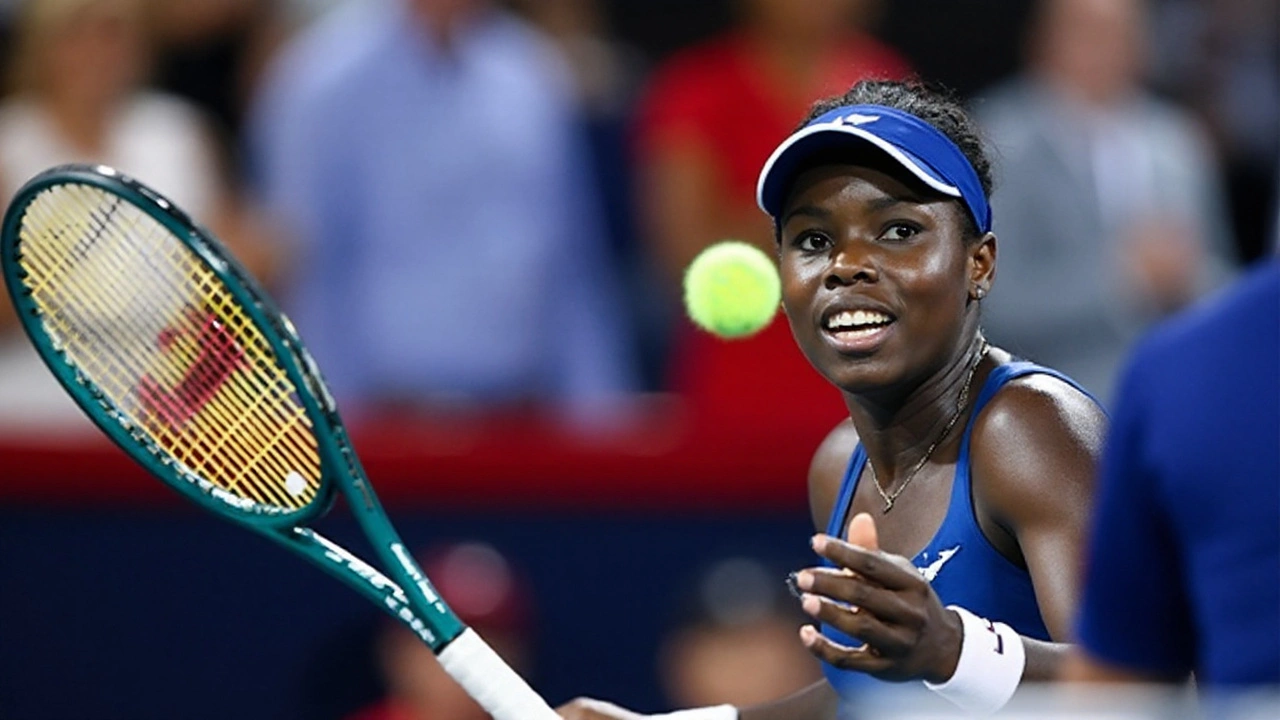Americans stack the seeds, giants collide, and two teenagers step into the fire
Half of the projected women’s quarterfinalists are American seeds, and the US Open draw reflects it. No. 3 Coco Gauff, No. 4 Jessica Pegula, No. 6 Madison Keys, and No. 8 Amanda Anisimova all landed in strong positions for the season’s final Slam in New York. If seeding holds, Gauff and Keys are on a collision course for a blockbuster quarterfinal — a marquee night-session kind of match that usually tilts the mood of the whole tournament.
But the draw doesn’t revolve around the home favorites. Defending champion Aryna Sabalenka landed in the same quarter as No. 7 Jasmine Paolini, a potential heavyweight slugfest if both get there. Iga Swiatek, arriving with fresh confidence after taking the Cincinnati title, is positioned for a possible rematch with Anisimova — the kind of stylistic contrast that has caused Swiatek problems in the past. Layer in the reigning Wimbledon champion Barbora Krejcikova somewhere in the mix and this field looks as deep as it has all year.
The first quarter is stacked with form players. No. 9 Elena Rybakina made the Cincinnati semifinals and pushed Swiatek in straight sets that were closer than the scoreline suggested. No. 14 Clara Tauson surged in Montreal and now opens against Alexandra Eala, the 20-year-old Filipina who has been climbing fast since spring. No. 24 Veronika Kudermetova, a semifinalist in Cincinnati, could face Rybakina in round three. And No. 31 Leylah Fernandez, who won the Mubadala Citi DC Open, sits in a lane that could meet Sabalenka by the third round if she keeps her level.
That’s the shape of the top of the draw. The bottom half isn’t soft either. Pegula’s side features ball-strikers who love hard courts and make you earn every point. Anisimova’s corner is tricky, too — she can catch fire, but New York also exposes any rust or hesitation. Add in Krejcikova, who loves a big stage and has settled into a measured, risk-first game on hard courts, and the path to the second week looks tight everywhere you look.
Two names, though, cut through the noise: Alexandra Eala and Victoria Mboko. Neither is seeded. Both have made real strides in the last 12 months. And both drew early hurdles that will tell us a lot about where they stand against the tour’s middle class — the part of the ranking ladder where matches become about decision-making under pressure as much as raw shotmaking.

Rising prospects: Alexandra Eala and Victoria Mboko
Eala’s year has been the headline turn. She reached the Miami Open semifinals in March, taking out established champions — including Iga Swiatek — with flat, early-taken returns and a willingness to step inside the baseline on big points. She cracked the top 100 (a first for a Filipina), peaked at No. 56 in June, and sits around No. 75 heading into New York. Grand Slams are a different rhythm, though. She got her first main-draw starts at Roland Garros and Wimbledon, and both ended in round one. That’s typical for newcomers: best-of-three at Slams isn’t about surviving one hot set; it’s about managing momentum swings over two hours while the opponent keeps adjusting.
Her opener against Clara Tauson is the kind of draw that can forge belief or sting for weeks. Tauson’s ball is heavy through the court, and she loves redirecting pace up the line. Eala’s edge is court sense and speed — she gets to balls you don’t expect and flips defense into offense quickly. If she blunts Tauson’s first-strike patterns and keeps the rallies cross-court until she finds the forehand window, the match opens up. If not, she’ll be playing from behind in almost every game. One more layer: New York’s night sessions can get humid, which slows the ball and helps counter-punchers. If Eala lands on that schedule, it favors her legs.
Mboko’s rise has been steady rather than splashy. The 18-year-old Canadian won a National Bank event on home soil this summer — not a tour-level crown, but a meaningful step that gave her match reps and a booster shot of confidence. Her game is built on a clean first serve and a forehand that holds up under pressure. The issue for young players in her spot isn’t one shot so much as the fourth or fifth ball in a rally when a veteran drags the point into a pattern she doesn’t love. In New York, she’ll see those patterns early and often. Expect opponents to target her backhand corner, stretch her wide, and then force her to hit on the run.
What do good early weeks look like for them? For Eala: hold around 65–70% of service games, keep return depth above the service line, and limit mid-rally forehand errors. For Mboko: protect second serves with body targets, keep the forehand-to-forehand exchanges neutral until she can step in, and take returns early on second serve to cut time. If either turns those dials in the right direction, a third-round run is in play.
Zooming back out, the draw’s storylines stack up fast:
- Home crowd energy: Gauff, Pegula, Keys, and Anisimova will get prime-time slots. The noise in Ashe isn’t subtle; some players feed on it, others shrink. It matters in breakers and long deuce games.
- Sabalenka’s quarter: If she sees Paolini, expect a power-versus-variation duel. Sabalenka’s best tennis on this court still overwhelms, but Paolini’s balance and counterplay can pull power hitters into awkward positions.
- Swiatek’s half: With Cincinnati in her pocket, she’s comfortable again on hard courts. The question is whether opponents can jam her forehand with pace or high bounce and move her out of patterns she loves.
- Rybakina’s lane: If healthy, she’s a problem for anyone. The serve plus backhand combination travels well. Her third-round potential against Kudermetova (if it lands) would be a serving clinic.
- Leylah’s spark: That DC title came with tight wins in ugly-scoreline matches — exactly the kind of battle that prepares you for New York’s chaos.
The surface always shapes this tournament. Day sessions zip through with quick winners and aggressive second-serve returns. Night conditions slow down, favoring players who can absorb pace and turn defense into offense. That’s why the scheduling lottery matters. A first-week night match can become a four-break slugfest, especially if the wind sneaks in and messes with ball tosses.
On paper, the Americans have the cleanest routes. Gauff knows these courts. Her first serve helps her win quick points and avoid the long baseline exchanges that sometimes trouble her. Keys has the kind of blunt-force power that can rip through early rounds if the timing is there. Pegula’s draw tends to be about discipline more than danger — if she plays her patterns, she usually reaches the second week. Anisimova is the X-factor: if the first-strike timing lands, she’s a threat to anyone, even when she hasn’t logged a heavy match load.
The seeding also sets up some nasty early matches for seeds you might pencil into week two. Kudermetova, often a tough out at hard-court events, can stumble if she’s dragged into long defensive exchanges. Tauson, despite her Montreal run, still has stretches where the forehand flies on her. Rybakina has had minor physical niggles in recent summers — if she’s 100%, she’s a title threat; if not, she’s vulnerable to deep-returners who chip and charge her second serve.
And then there’s Krejcikova. Her Wimbledon title came on rhythm and clarity: take time away with the return, hold the backhand line, and mix in slices to reset points. On hard courts, that backhand still pays rent. The part that can wobble is the defensive forehand in the alley, where fast courts expose footwork. If she cleans that up, her section of the draw becomes more than a landmine — it becomes a lane to the semis.
For the unseeded, the ask is simple but brutal: win the small moments. Break points in New York aren’t the same as in week-two Rome or a quiet court in Charleston. The crowd grows into points here. Players who take a breath and go to their best pattern on the biggest points tend to stick. Players who reach for a hero ball early in a rally usually don’t.
If you’re looking for first-round matches that could flip the script, start with Tauson vs. Eala. It’s a pure test of execution. Keep an eye on any Rybakina opener against a fast returner; if she drops her first-serve percentage, it gets complicated fast. And watch for Fernandez if she draws a heavy hitter who can’t move comfortably. That’s when her counterpunching turns the court into a maze.
What would a surprise run from Eala or Mboko actually require? Not miracles. Just two things: a protected serve under stress and clean decision-making at 30-all. Eala’s speed can cover a lot, but she’ll need cheap points on serve to stop the scoreboard from tilting. Mboko needs to avoid streaks of rushed errors on the backhand. Both will face experienced opponents who understand how to change ball height, spin, and speed to push them off their favorite zones. Winning anyway is the whole point.
As for the title picture, it’s crowded. Swiatek carries form, Sabalenka carries the belt, Gauff carries the building, and Krejcikova carries the calm. Pegula lurks. Keys can hit through anyone on the right night. Anisimova can detonate a section with two clean matches. By the time we hit the second week, the draw should reflect who handled the noise and who blinked.
Until then, the focus stays on the kids with something to prove. Eala has the résumé bump — a Miami semifinal and a high-water ranking for Philippine tennis. Mboko has the momentum of a summer title and the upside of an 18-year-old with a heavy forehand. Their first rounds aren’t friendly. But New York doesn’t do friendly. It does tests. And both just got big ones.

Arlen Fitzpatrick
My name is Arlen Fitzpatrick, and I am a sports enthusiast with a passion for soccer. I have spent years studying the intricacies of the game, both as a player and a coach. My expertise in sports has allowed me to analyze matches and predict outcomes with great accuracy. As a writer, I enjoy sharing my knowledge and love for soccer with others, providing insights and engaging stories about the beautiful game. My ultimate goal is to inspire and educate soccer fans, helping them to deepen their understanding and appreciation for the sport.
view all postsWrite a comment